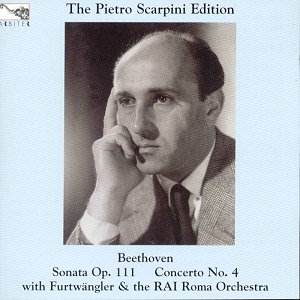Arbiter
here inaugurates the first of their series dedicated to the under-appreciated
art of Pietro Scarpini (1911-1997). Devoted though he was to the
masterpieces of the repertoire – his recitals of the Diabelli
and Goldberg Variations were renowned – he also embraced Janáček,
Schoenberg and Dallapiccola, who was a good friend. Scarpini had
studied piano with Casella and composition with Bustini and Hindemith,
counting Molinari as his mentor in conducting – and it was the
latter who first conducted for him in 1937. His career grew after
the War and he travelled internationally but his name was not
widely known beyond connoisseurs. Part of the reason was his reluctance
to record and the mantle of Italy’s leading pianist had by then
been grasped – not that Scarpini would much have carried for the
gladiatorial aspect – to Michelangeli. It’s timely then that this
disc should appear and it shows Scarpini’s strengths in their
considerable depth.
The
Concerto performance was his only encounter with Furtwängler.
The sound is adequate to good and certainly not unpleasant but
it is somewhat constricted sonically, dating from 1952. The conductor
elicits some pensive and withdrawn orchestral statements from
the RAI orchestra, vesting the opening movement with a real sense
of volatile withdrawal. Scarpini has just the right degree of
lyric elasticity for Furtwängler’s kind of conducting and
gives a great freedom to the piano part, a flexible, spontaneous
sounding generosity of utterance. The Elysian flutes are here
answered by gruff piano entries almost foreshadowing the orchestral/solo
exchanges in the Andante con moto. There are certainly some mighty
accelerandi here as well as a tense series of dynamics. In that
slow movement one derives the feeling that this is less a dialogue
between orchestra and piano and more a kind of dramatic monologue,
of Shakespearean depth, in which by some alchemy it is as if the
piano were playing all the way through and it is we who fail to
hear. Though the outer movements are relatively slow, Furtwängler
gives impetus to the rhythmic material and it never seems unduly
slow. The conclusion isn’t especially neat playing but it is exciting
and powerful.
Coupled
with the Concerto is the Op.111 Sonata. From 1961 and in good,
quite close-up sound (one can sometimes hear the pedal), this
is a noble and acute performance that combines considerable richness
of tone with a superior analytic mind. His command of the rhetoric
is undeniable, the comprehensiveness and cohesion of the interpretation
admirable.
So
this is an admirable start to the Scarpini series. It comes with
some worthwhile documentation – a biographical note, a career
highlights compiled by Scarpini himself and a newspaper interview.
He seems to have been almost as elusive on print as he proved
to be on disc. Warmly recommended.
Jonathan
Woolf
